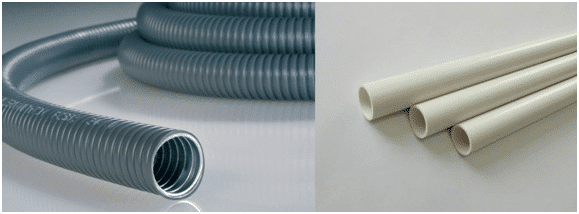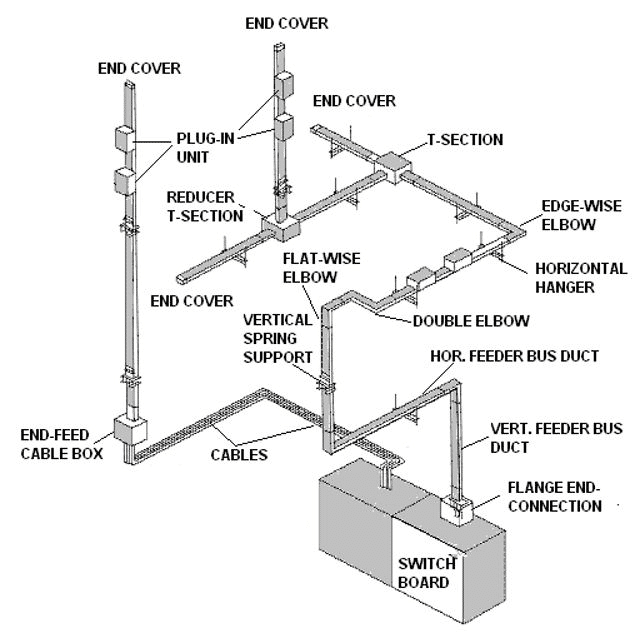
You can find raceways in your home inside walls, in the office where you work and many other places. So let’s start by defining what raceways are.
Let your fellow electrical engineer Yasser tell you more about raceways in internal installations…
What is Raceway?
According to NEC (National Electric Code) raceway is a metallic or nonmetallic enclosure (pipe or channel) which is designed to hold cables, keep them safe from any mechanical stress and provide safe route for them. It includes metal and non-metal conduits, surface and underfloor raceways and busways.
There are many types of raceways and we will discuss the most common types and the differences in application and properties.
Conduits
Conduits are tubes or pipes made of metal, plastic (PVC) and can be flexible or rigid as follows:
- Galvanized steel rigid/ flexible conduit: used in industrial and commercial applications to protect the wires which is expressed to mechanical stress and it’s very reliable in highly corrosive environment with chemicals.
- Rigid/ Flexible non-metallic conduit (PVC): this type of conduits are commonly used in residential (in walls) and also buried underground, it’s non-conductive, light, cheap, and flexible and the tight joints make it water resistant.
- Flexible metal conduit (FMC): in case that the cables route is facing many curves and the area itself has vibrations and movements then the flexible conduit is the best as it will keep the cables safe from mechanical disturbance but it’s not recommended to be placed in corrosive environment.

Figure 1: Flexible and rigid galvanized conduit

Figure 2: Flexible and rigid PVC conduit
Important notes
- In metallic conduits you mustn’t place a single phase cable in a conduit as the resulting magnetic field will induce currents in the conduit which will raise its temperature causing the cable to be burnt.
- Fire barriers must be placed between normal conduits and emergency ones.
- Communication cables shouldn’t be placed in the same conduit with power cables, to reduce interference.
Conduits are not good in places with many modifications in branch circuits, as in this case you need to do some civil works to do any modification. Thus surface and underground raceways are a better solution if your facility are changeable and would need to change receptacles position or number of circuits and so on.
Raceways
Raceway is an enclosure in shape of channel to hold, protect and provide routing for cables.
- Surface Raceways:
Channels made of metal or plastic (PVC) which mounted on walls and have wires running inside it, you can add more wires to it and modify the whole wiring of your facility. It’s commonly used in offices where it may need to change a plug position as the nature of work changes. - Underground Raceways:
It’s the same as surface raceways but it is installed under the floor and is commonly used in buildings which contains huge servers and contains many cables.
Raceways are good for the ability of modification and troubleshooting is very easy as the cables are accessible so maintenance also is easier.

Figure 3: wall mounted raceways layout
Busways
Busway is an electrical distribution system consists of bus-bars in a protective enclosure, which is used in many applications instead of cables. It’s mainly used for high building risers and when there are many loads on the building’s roof so in this case cables are not economical. It’s also called as bus duct.

Figure 4: Underground Raceway in a server building
Advantages
- Not so affected by temperature like cables.
- Very high current carrying capacity.
- Higher short circuits withstand.
- Easy in maintenance and troubleshooting.
Disadvantages
The disadvantage of busways is the cost; busways are really expensive so it doesn’t replace cables always except as mentioned above.

Figure 5: Bus Duct distribution system
So choosing the type of raceways to be installed in your facility is not hard to do, but it’s very important thus you should take into your consideration the nature of the facility, number of cables, whether the environment is chemically polluted or not and many other factors that may guide you to choose a specific type of raceways over another one.
Yasser.
What’s your opinion on that back to basics type of article?